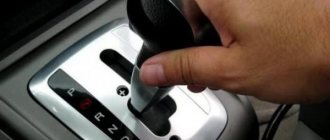Lada Vesta is equipped with one of two gasoline engines – 21129 (1.6 l.) or 21127 (1.8 l.). The control system is electronic. Initially, the operation of the computer and feedback sensors is finely tuned. However, over time, a problem arises - instability of speed at idle and while driving. Determining the exact cause is often difficult due to the fact that the Check Engine light does not light up, so scanning the ECU is useless. Still, you can identify the flaw of uncomfortable functioning on your own.
Check and test
I removed the lower fitting of the adsorber valve, the plug with wires. I applied 12 volts to the valve and it opened. When I removed the throttle, I plugged the hole on the back side. He took a cigarette and lit it. When the valve was open, I blew into it. With my other hand I blocked the second channel into the intake manifold. What do you think happened? Smoke came out of the hole.
As a result, I concluded that the connections of the tube going from the valve to the intake manifold were leaking. Therefore, air is sucked in in a large volume. Everything below the canister valve does not need to be sealed. This does not affect the operation of the Lada Vesta engine, since air flows freely into the adsorber through the white fungus.
What methods have you tried?
On the Internet I found different solutions to the problem when the Lada Vesta twitches, and I used them. Some people advised putting caps under the clutch pedal sensor. Others argued that if you fill a full tank of gasoline, the car will jerk.
I tried this out, filled the tank full for a week, then drove with an almost empty tank. I didn't notice any difference.
Then they told me that a vacuum was being created in the tank, so the fuel pump pumped poorly and did not create the required pressure. They advised to put a cap with a valve from Renault Logan on the fuel tank. It fits Vesta. This also did not help; the standard factory plug has the same valve.
Poor hood seal
For the first year and a half, Vestas were fitted with a hood seal of two halves with a gap in the center near the lock. It was there that dirt broke through under the hood in huge quantities. Over 15–20 thousand km, the engine compartment becomes suitable for planting vegetables.
Later the plant switched to solid rubber. The trouble is that in the central part it is still not glued. The rate of contamination of the engine compartment has decreased, but has not become zero. Lovers of cleanliness still need to do “collective farm” work in every nook and cranny of the car. And not only them: Vesta is so dirty in this part that even checking the oil level is unpleasant.
- A wide range of auto chemicals and many useful car accessories can be found on the pages of the Za Rulem store.
The right way
Finally, they gave me some good advice: check the tube between the canister valve and the intake manifold. In fact, a large vacuum is created in the starting system. If there is air leaks in the tubes, the fuel mixture will become lean. As a result, the engine will jerk.
I checked the fitting of this tube at the entrance to the manifold - it was loose.
At the second end of the hose, the same thing happens - the fitting moves and is not seated tightly.
The adsorber itself, which is made in the form of a white fungus (visible below in the photo), sucks air from the atmosphere. Due to the vacuum in the intake manifold, gasoline vapors are sucked into the intake system through the canister ventilation valve.
There is a green rubber ring installed in the fitting. It should seal the connection well. To check the quality of the seal, we had to conduct an experiment.
Scratched glass
Another problem for Vesta, which appeared immediately after the start of sales. Vertical scratches appeared on the side windows in just a few lifting and lowering cycles. It was all blamed on the door seals being too rigid and too close together.
Dealers cut them and changed them, but, according to our observations, it helped little. Judging by the number of abrasions and small chips on the windshield of the editorial car, Vesta uses too “soft” glass. But here the plant did not make any changes: they continue to install the same Sisecam on the cars.
How to troubleshoot
All that matters to us is the ill-fated pipe in question.
The order of my actions (step by step instructions):
- I removed the wallpaper from the ends of the tube.
- I measured the diameter of the inlet pipe with a caliper: it turned out to be 8 mm.
- I didn’t wrap electrical tape or fum tape around it or lubricate it with grease. I decided to make it more reliable. I carefully examined the tube and found no defects. But for some reason the air is sucking in. A tube with a diameter of 8 mm fits into the fitting. We need to come up with something to improve the tightness. I recently replaced the flexible hoses on my kitchen faucet. I remembered that there is a rubber ring on the hose.
- I measured the bore diameter, and it turned out to be 8 mm too. So the ring should be ideal for our case.
- I bought 3 plumbing repair kits to get rubber seals from them. I couldn’t buy the rings separately—I couldn’t find them on sale. It would cost 5 rubles, no more.
Kits are sold by different manufacturers, and the sizes of sealing rubber bands may vary. Therefore, if you use a ring that is too thick, you may break the plastic fitting. The place where the latch is attached may also break off. I am not imposing this procedure on anyone, use the advice at your own responsibility. But it helped me solve the problem.
I tried to put the elastic band on the pipe - it stood up like a native one! Maybe AvtoVAZ forgot to install them. Of course, they are not oil resistant, but in this case this will not matter. I put the fitting on top and it was a little loose. I put on the second ring - also rather weak. Then he put on the third one.
After that I put the fitting on tightly, it turned out very tight. From the other end of the tube I performed similar procedures. Now nothing is loose. I installed a decorative engine cover.
Stabilizer bushings creaking
This is perhaps the first mass criticism of the brand new Vesta. The cars began to be sold at the end of November 2022, and even before 2016 began, unflattering reviews began to pour in.
At first, dealers lubricated the squeaking rubber bands, then the factory offered a replacement. Which, by the way, still creaks for some particularly “lucky” newsreaders.
The people's ingenuity did not stand aside either. People massively selected alternative parts from foreign cars, simply focusing on similar dimensions. You can find more than a dozen different options on the Internet, from popular to elite. They didn’t experiment with the editorial machine, and at the next maintenance the dealer replaced the bushings with modernized ones under warranty. It became quiet.
Terms of service
The knot itself can be removed anywhere. This can be done in the garage. But usually, the unit is removed near the client’s entrance. We remove the knot. Let's go home. Sharpening. We take it out, install it, check it. You don't have to drive across the city, stand in traffic jams, etc. You save a lot of time and nerves.
If you have the opportunity and your superiors, we can provide the service right at your place of work. You can drive home from work with pleasure from the way your car drives. The service can also be provided with travel to nearby settlements from the city, which can be reached by bus or train. In this case, transportation costs are added to the cost of the service. In any case, these expenses will cost you less than your arrival. You can save on transportation costs if you cooperate with someone and the service is provided to someone else besides you.
* To work you need a small table, chair and 220V.
And, of course, it is desirable that the car is clean. Or there was some kind of rag to cover the dirty fender of the car. It is also necessary to have a rag for washing the throttle.
For reference: sawdust does not fly all over the space. Metal filings don’t go anywhere beyond the newspaper.
Engine oil burner 1.8
The VAZ 1.8 engine with a power of 122 hp took a long time to reach production cars. I was upset by three things: I turned out to be not so cheerful, I was hungry for gasoline and oil. Of course, oil loss is not on such a scale as on other turbo engines, but before Lad engines were not noticed in this way in principle, and therefore the topic has become acute.
Fuel consumption in traffic jams is good for 10 l/100 km, the owners of the West 1.8 just have to come to terms with it. But AVTOVAZ indirectly acknowledged two other problems by upgrading the engine. To improve traction characteristics, the firmware was changed. Maslozhor was eliminated by a whole range of modifications to the hardware and assembly process.
There seem to be fewer complaints, but evidence of increased consumption still occurs. Those who attended a long-term test in the editorial office of Vesta with a 1.8 engine also noted this.
The main disappointment in the car: A motorist spoke about the problems with the 1.6 106 hp engine in the LADA Vesta
The VAZ engine is the anchor that prevents Vesta from becoming a modern car.
Photo: LADA Vesta 1.6, source: m.auto.ru
The main complaint about the 1.6-liter VAZ-21129 engine with a power of 106 horsepower, designed and assembled by AvtoVAZ, is its archaic nature. This opinion was shared by a motorist on the YouTube channel “LADA Vesta Blog” after 4 years of ownership. But even this LADA Vesta has its advantages.
Archaic and problematic “129th”
Because of this, car owners have to face a lot of problems:
New LADA Vesta FL 2021-2022: What is known about restyling today
LED optics, a tablet a la Tesla in the cabin and a more powerful engine - these are the innovations the updated Vesta will boast. The platform and overall design have not changed, but many cosmetic ones have appeared.
Among the advantages of the “anchor”, motorists note its reliability, provided that the oil, filters and timing kit are changed in a timely manner. The engine surprises with its service life, reaching 300-400 thousand km without capital. The maintainability, simplicity and low cost of servicing the unit is enviable.
The engine lends itself perfectly to “chipping” and boosting up to 130-150 “horses”, if you want to “experiment”.
Photo: Exterior, interior and engine of LADA Vesta 1.6 AMT, source: YouTube and LADA
However, the “newsman” noted that now, having experienced all the shortcomings of the “archaic” engine, he would take the Vesta with a 1.6-liter 113-horsepower unit from Renault paired with a CVT.
In addition, the constant “tugging” of the manual transmission lever is a thing of the last century; even the “blunting robot” is more progressive and provides more comfort than the “handle”.
Source
Inoperative turn signal repeaters
LED turn signal repeaters in mirror housings turned out to be unreliable. At first they were leaky and were killed by moisture getting inside. Then they began to die completely and immediately, without the help of water. Failures are recognized as covered by warranty without any problems. Now her treatment is much simpler than in the early years of West's graduation. Then we had to wait for the delivery of assembled mirrors, already painted in the color of the body: long, expensive and stupid. Now only the optical element itself is changed. Owners of out-of-warranty cars need not worry: it retails for about 500 rubles.
Messages 11
1 Topic by Axel 2016-01-27 14:51:44
- Axel
- Participant
- Inactive
- Posts: 973
Topic: Gas pedal failure Lada Vesta
The first “glitch” appeared on about the third day - the gas pedal did not work! I stopped, turned it off, then started it again and everything became normal... I gave the car to my father and he had the same problem. I didn’t contact the dealer because I was away on a business trip...
The most interesting things began after my arrival. So I pulled the car out of the garage, drove to the village (15-20 km) and on the way back the same story - I press the pedal and there is zero emotion! I stopped, turned it off, started moving again and after 50 meters the same story... Somehow I made it to the parking lot of a local store. There the story became even more fun. I started the car and at idle it began to shake, the revolutions began to drop to 500, then the car stalled. I had to take it to the dealer with a tow truck.
At the service center, Vesta started up without any problems and everything was fine. I drove around the city with the master, who until recently did not understand what kind of problems I had. However, after a kilometer and a half, history repeated itself. Here the master himself got behind the wheel and felt the problem. The car had to be pulled back to the dealers by a cable.
There, after about an hour and a half or two hours of waiting, I was informed that all systems were normal and no errors had been identified. Let's go for a ride again. This time, it’s not clear why, everything was fine. They said the problem was only in gasoline... But what about gasoline?! I only refuel with Lukoil and Rosneft 95 gasoline...
In general, they sent me home until the next breakdown, without returning the money spent on a tow truck... But how to drive?! Imagine if you need to avoid a collision or if you overtake a truck on the highway and the gas stops... It’s somehow scary...
They say that this is the first case noticed, but maybe someone had something similar? Share - I will be glad!
2 Reply from Ronnikkee 2016-01-27 15:28:27
- Ronnikkee
- Participant
- Inactive
- Posts: 36
- Thanks: 7
They said the problem was only in gasoline... But what about gasoline?! I only refuel with Lukoil and Rosneft 95 gasoline...
Judging by the sign it looks like gasoline. And refueling here does not mean that the gasoline is of high quality, anything can happen.
In general, they sent me home until the next breakdown, without returning the money spent on the tow truck...
If it happens again with other gasoline, then the problem will still be diagnosed and the money will be returned, maybe)
Refinement of a new electronic gas pedal
The pedal assembly (11183-1108500-01) does not have oval holes, which does not allow adjustment in the manner described above. Instead, it is proposed to cut off the protrusion (by 2-3 mm), which prevents the pedal from moving completely. This modernization made it possible to increase the pedal travel, which made acceleration with “pedal to the floor” more active. It is also noted that there is no hesitation when pressing the pedal sharply.
What I don’t like about the pedal assembly (8450008980), which is installed on Lada Vesta:
- tight gas pedal;
- large free play of the gas pedal (about 8 mm at the tip of the pedal).
What was decided to do:
- remove one of the return springs to make the pedal softer;
- Place a spacer to reduce the free play of the pedal.
How to measure pedal free play:
- Let's start the engine.
- Place a ruler at the tip of the pedal.
- Smoothly press the pedal until the engine begins to gain speed.
- We remember the distance on the ruler.
We remove and disassemble the electronic gas pedal:
- Disconnect the connector (by pressing the inside of the upper part of the latch)
- Unscrew three nuts (head “10”).
- Remove the top cover by unscrewing the fastening screws.
- Remove the rheostat slider by unscrewing the screw.
- Remove the spring (holding them with a screwdriver from the outside).
- Remove the white support spacers, remembering how they were installed.
- We measure the distance between the support pad of the return spring lever and the support rubber in the body, retracting the pedal to the amount of free play (indicated by an arrow).
- We glue the material of the same thickness (in this example we use 4 mm stickers for furniture legs and doors) using glue or double-sided tape.
We assemble the pedal assembly and install it in the car. The idle motion of the pedal should be minimal, about 1 mm. If the engine idle speed is higher than usual, and there is no free play of the pedal at all, then too much has been added. You will have to repeat the adjustment operation, adjusting the thickness of the lining. The same thing applies if the free play after adjustment remains more than 1-2 mm.
Lada Vesta twitches, what to do
On cars of the Lada Vesta family, one of the most common problems is considered to be jerking of the car, which can manifest itself when releasing the gas, driving at low speeds and when changing gears. The problem has been discussed since the first appearance of the Lada Vesta on the Russian market and occurred on models with 1.6 and 1.8 liter engines. In search of a solution to the jerking, procedures such as adapting the throttle and adjusting the clutch sensor using improvised means were carried out. Unfortunately, none of them was a universal solution; some owners spoke about improving the behavior of the car, but the twitching was not completely eliminated.










